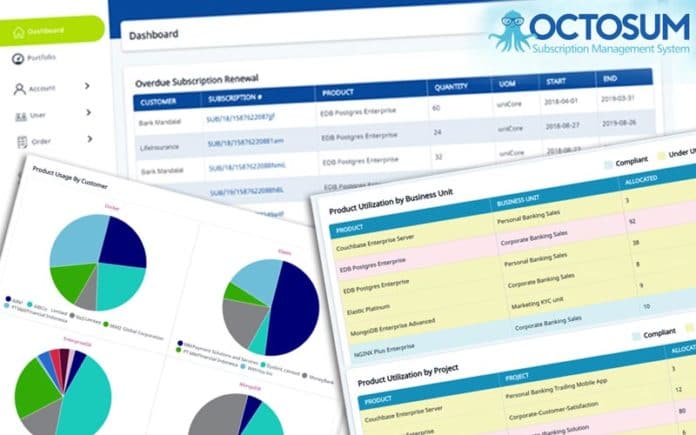Ashnik is an enterprise open source solutions and consulting company based in Southeast Asia and India. It recently developed Octosum, an intelligent open source subscription management System as a Service. Sandeep Khuperkar, CTO and director at Ashnik; Sachin Dabir, CEO and founder, and Deepti Dilip J., head and director of marketing, participated in an exclusive interaction with Sreejani Bhattacharyya and Niraj Sahay of OSFY to discuss more about this platform.
Octosum is a subscription management system that brings together procurement, compliance, IT and business teams on a unified platform. The Octosum platform from Ashnik is based on years of experience with open source technologies. The entire backend of the system is based on open source software too. Sandeep Khuperkar, CTO and director at Ashnik, says that enterprises and vendors face different challenges in managing their open source subscriptions.
“The product offers separate interfaces for organisations and vendors since both have unique needs of their own. We developed this system from the ground up. While developing this, we worked with customers to understand their challenges, and aligned their inputs while designing the solutions. That is the reason why the sophistication of the platform has reached this level,” he explains.
Octosum optimises subscription utilisation. It allows the customer to view the number of subscriptions deployed and available for deployment through customised dashboards. As per the company, it helps in managing the allocations of subscriptions to projects. This makes it simpler to allocate or re-allocate as per project requirements.
One can also schedule the view of upcoming renewals to plan the budget cycle and evaluate usage of subscriptions.
The intelligent subscription management platform
Sachin Dabir, CEO and founder, Ashnik, says, “Octosum brings the procurement, compliance, IT and business teams on a unified platform. It projects how many subscriptions are actually released, how many are currently allocated and how many are being deployed – all on one single platform. That’s how it eases the subscription life cycle.”
He adds, “Subscription has become almost the standard way of procuring software. Also, nowadays, IT, business and compliance teams play an active role in the procurement cycle. Hence, it has become important to modernise the entire cycle – both with respect to technology and to processes.”
“This is a unified subscription management platform that can help IT teams to get rid of spreadsheets for managing subscriptions and licences. In many organisations, spreadsheets are still the most commonly used tool for managing purchases and subscriptions,” says Dabir.
The company also claims that Octosum comes with real-time reporting that will help in better planning and decision-making in terms of available resources. It has pre-loaded NDAs (non-disclosure agreements) and contracts that help in effective vendor management and faster turnaround time.
So, why the name Octosum? Deepti Dilip J., head and director of marketing, says, “When the brainstorming began for product names, we wanted it to be a solo word and easy to remember. The idea behind the logo and branding was to represent an animal synonymous with intelligence and multi-tasking abilities. The octopus is known to be the most intelligent sea animal and is a multi-tasker, which is how it became the icon and inspiration behind the name. The ‘sum’ part in Octosum is an abbreviation for subscription management.”
So why did they feel the need to develop this platform?
“All of us have been working in the open source space for a long time. When we went to organisations to renew subscriptions, we noticed that most of them had no system to figure out about their renewals of different subscriptions. This created challenges not only for procurement but also a risk of non-compliance,” Dabir explains.
Free for the use of enterprises till June 30, 2021
For the first year till June 30, 2021, the company will provide Octosum for the use of enterprises, free of cost. Based on the feedback and how it is being leveraged, the company will create a billing model. Dabir adds, “We want it to be easy from the consumption as well as billing point of view.”
Octosum is not only useful for enterprises but also for vendors. The company says that it will help to connect with a larger customer base as well as in scaling business. It will also help to connect with multiple customers and to keep track of all sales.
Viewing all subscriptions in one place will lead to better efficiency and effective sales, as all sold subscriptions, customer-wise, will be organised on a single platform. One can share certificates too with the customer through this platform.















































































